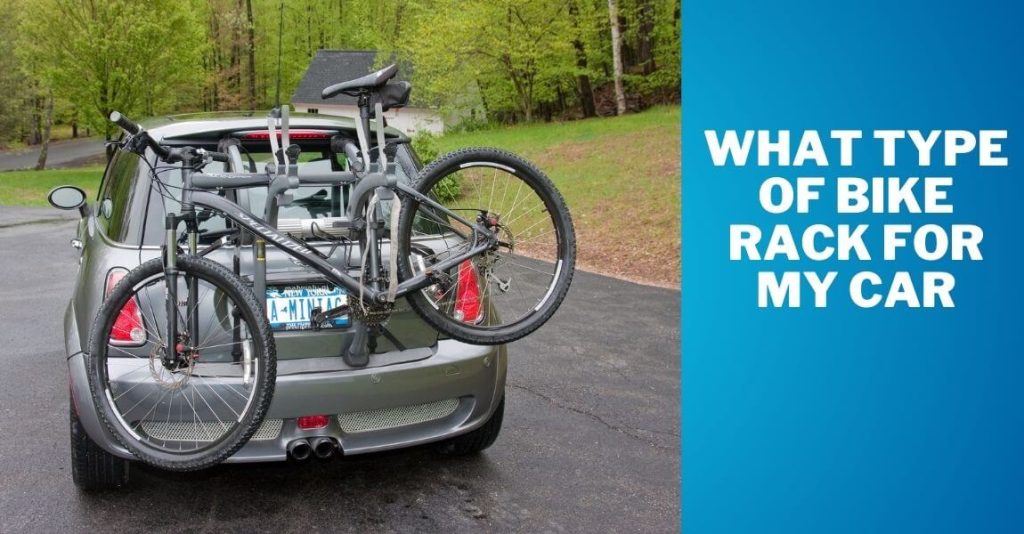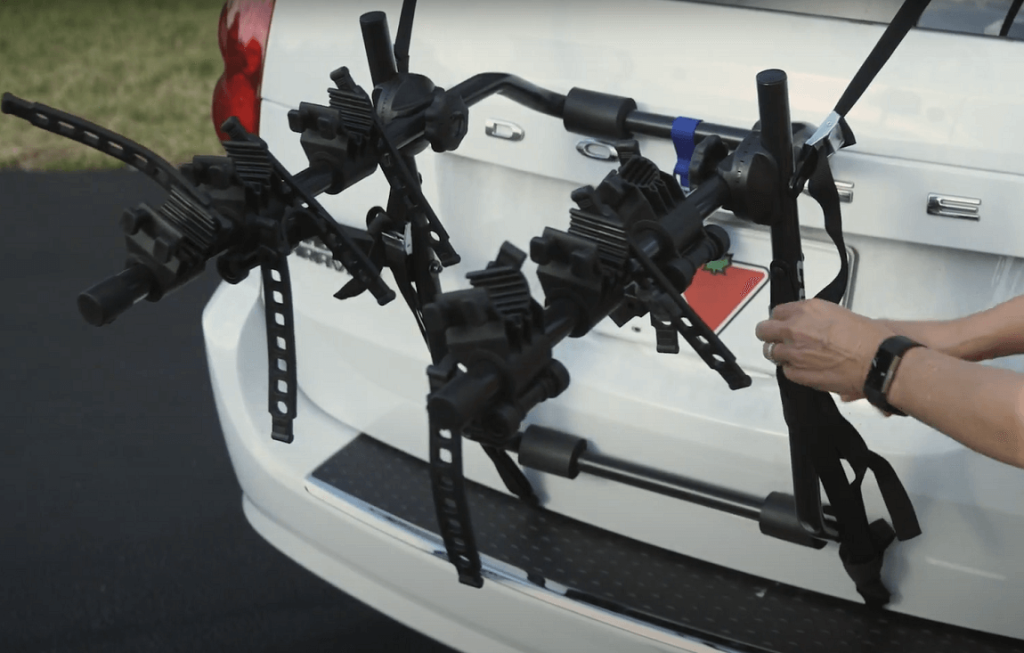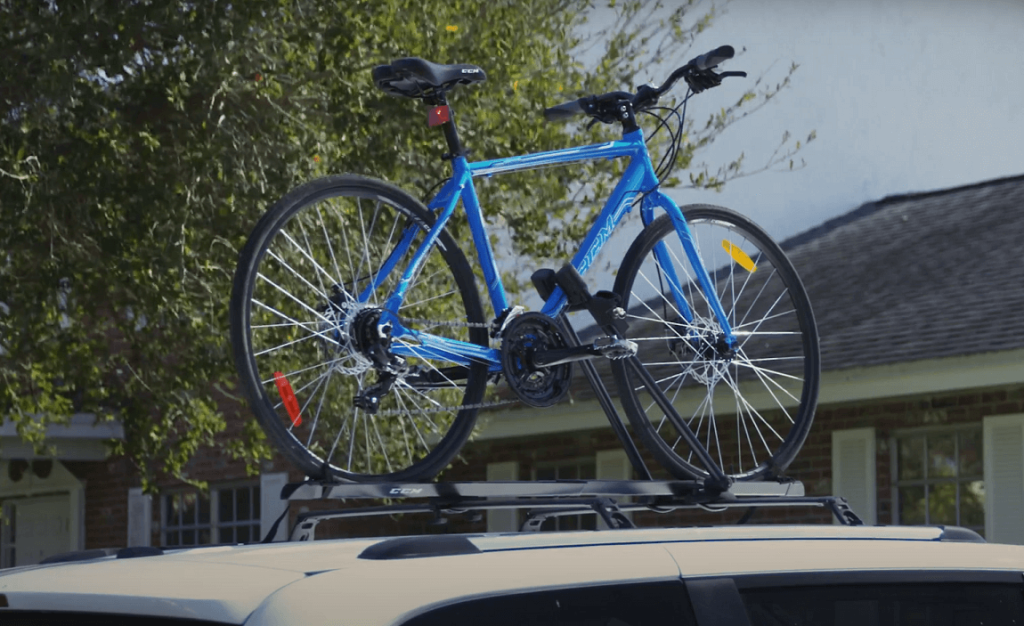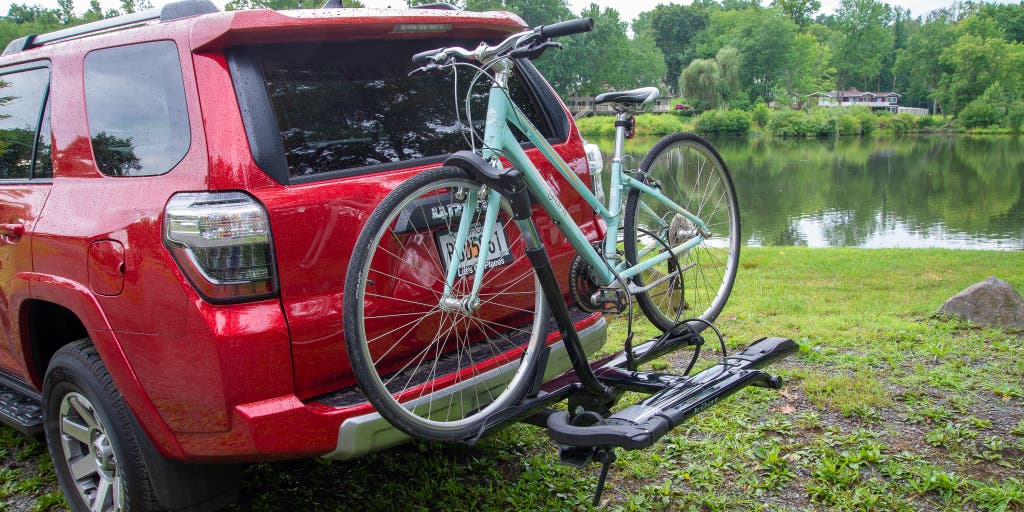Last Updated on September 6, 2023 by Mark S. Taylor
For a car, a roof-mounted bike rack is a popular and practical option. It securely attaches to the crossbars and keeps your bike safe during transportation.
Roof-mounted bike racks are versatile and compatible with most cars, making them a great choice for bike enthusiasts on the move. When choosing a bike rack for your car, it is important to consider your specific needs and preferences. There are several factors to keep in mind, such as the type of bike you have, the number of bikes you want to transport, and the ease of installation and use.
Additionally, you should consider the compatibility of the bike rack with your car’s make and model, as well as any additional accessories or features you may require. We will explore the different types of bike racks available for cars and provide tips on how to choose the right one for your needs. Whether you are an avid cyclist or simply enjoy occasional bike rides, finding the right bike rack will ensure a smooth and hassle-free transportation experience. So let’s dive in and discover the perfect bike rack for your car.

Contents
Why Choosing The Right Bike Rack Matters
Selecting the right bike rack for your car is crucial to ensure a safe and hassle-free transportation experience. With countless options available in the market, it’s essential to consider certain factors to make an informed decision. Let’s delve into the reasons why choosing the right bike rack matters.
Protecting Your Bike During Transportation
When transporting your bike, it’s important to safeguard it from potential damage or accidents. Using the appropriate bike rack can significantly contribute to the protection of your valuable bicycle. Here are some key points to consider:
- Stability: A sturdy and secure bike rack prevents your bike from wobbling or swaying during transit, reducing the risk of scratches or dents.
- Anti-vibration technology: High-quality racks often feature anti-vibration mechanisms that minimize shock absorption, ensuring your bike stays intact even on rough terrains.
- Soft padding: Look for bike racks with soft padding or cradles to protect your bicycle’s frame from scratches or abrasions caused by metal-on-metal contact.
Ensuring Compatibility With Your Car
Every car has its own specifications and compatibility requirements when it comes to bike racks. It’s crucial to choose a rack that seamlessly fits your vehicle to guarantee a safe and secure attachment. Consider the following points:
- Hitch compatibility: Determine if your car has a hitch receiver or roof rails to determine the type of bike rack suitable for your car.
- Weight capacity: Be aware of your car’s weight capacity to ensure it can support the combined weight of the rack and bikes.
- Clearance: Consider the height and length of your vehicle to ensure the bike rack won’t interfere with its functionality or obstruct visibility.
Ease Of Installation And Use
Installing and using a bike rack should be a hassle-free experience. Here’s why it’s important to prioritize ease of installation and use:
- Quick installation: Look for racks with user-friendly designs and minimal assembly requirements to save time and effort.
- Easy loading and unloading: Opt for bike racks that allow for effortless loading and unloading, minimizing strain on your back and avoiding potential injuries.
- Compactness and portability: Consider foldable or compact bike racks that can be easily stored when not in use, freeing up space in your garage.
Investing in the right bike rack ensures you have peace of mind, knowing that your bike is safe and secure during transportation. Take the time to assess the compatibility, stability, and ease of use of different bike rack options available before making a decision.
Remember, choosing the right bike rack is an investment in both your bike’s protection and your overall transportation experience.

Factors To Consider When Choosing A Bike Rack
Transporting your beloved bikes safely and securely is essential when planning a trip or outdoor adventure. Choosing the right bike rack for your car can make all the difference in ensuring a smooth and hassle-free journey. Here are some key factors to consider when selecting the perfect bike rack for your needs:
Car Type And Compatibility
- Assess the type of car you own as it will determine the appropriate bike rack options.
- Consider the availability of hitch receivers, roof racks, and trunk-mounted racks for your specific car model.
- Ensure compatibility between the bike rack and your car’s design and dimensions for a secure fit.
Number Of Bikes To Transport
- Determine the number of bikes you need to carry on your journey.
- Opt for a bike rack that offers sufficient capacity, taking into account both current and future needs.
- Consider the weight limit of the bike rack to avoid any potential damage or safety hazards.
Security Features
- Invest in a bike rack that provides adequate security measures to keep your bikes safe during transit.
- Look for features such as lockable mounts, anti-theft mechanisms, and sturdy construction to deter theft and prevent any accidental damage.
- Consider additional accessories like cable locks or integrated locking systems for extra peace of mind.
Budget And Affordability
- Determine your budget for a bike rack and focus on options within your price range.
- Research various brands and models, comparing prices and features to find the best balance between affordability and quality.
- Take into account long-term durability and maintenance costs to ensure a cost-effective investment.
With these factors in mind, you can confidently choose the most suitable bike rack for your car and enjoy worry-free journeys with your bikes securely in tow. Remember to prioritize compatibility, security features, bike capacity, and affordability to make the most informed decision.
Happy travels and happy cycling!

Hitch-Mounted Bike Racks
Benefits Of Hitch-Mounted Racks
Hitch-mounted bike racks are a popular choice among cyclists for several reasons. They offer numerous benefits that make them a top choice for those looking to transport their bikes securely and conveniently. Here are some key advantages:
- Versatility: Hitch-mounted racks are compatible with various car models and can be easily installed on most vehicles that have a hitch receiver. This makes them a versatile option for cyclists with different types of cars.
- Accessibility: Unlike roof-mounted racks that require lifting the bikes overhead, hitch-mounted racks are situated at a lower level, making it easier to load and unload bikes. This accessibility is especially beneficial for those with heavier bikes or limited upper body strength.
- Better aerodynamics: By using a hitch-mounted rack, you avoid the added wind resistance caused by a roof-mounted rack. This not only enhances your vehicle’s aerodynamics but also improves fuel efficiency during travel.
- Increased carrying capacity: Hitch-mounted racks are designed to carry multiple bikes, making them an excellent choice for families or groups of cyclists. Depending on the model, some racks can hold up to four or five bikes at once.
- Improved stability: Thanks to their sturdy construction and attachment to the vehicle’s hitch receiver, hitch-mounted racks provide better stability during transportation. This reduces the likelihood of bikes swaying or shifting during the journey.
Types Of Hitch-Mounted Racks
When it comes to hitch-mounted bike racks, there are two main types to consider: platform style and hanging style. Each type offers different features and advantages, catering to specific needs and preferences.
Platform Style
- Design: Platform-style racks feature a tray-like platform where the bikes rest horizontally. They often have adjustable wheel clamps or straps to secure the bikes in place, keeping them stable during transit.
- Easy loading and unloading: With their lower height and user-friendly design, platform-style racks make it effortless to load and unload bikes. The bikes can be easily rolled onto the platform and secured with minimal effort.
- Enhanced bike protection: These racks typically provide better bike protection compared to hanging-style racks. The platform design eliminates contact between the bikes, preventing scratches or damage caused by bike-to-bike contact.
- Versatility: Platform-style racks are versatile in accommodating different bike sizes and styles, including fat tire bikes, mountain bikes, and even electric bikes. They often come with adjustable features to adapt to various bike frame sizes.
Hanging Style
- Structure: Hanging-style racks suspend the bike by the top tube or frame, allowing the bike to hang vertically from the rack. The bikes are usually secured with adjustable straps or cradles that hold them in place.
- Affordability: Hanging-style racks are generally more affordable compared to platform-style racks. If you have a limited budget but still need a reliable bike transportation solution, a hanging-style rack could be an excellent choice.
- Lightweight and compact: These racks are typically lighter and more compact than platform-style racks, making them easier to store when not in use. They also tend to be easier to install and remove from the vehicle.
- Multiple bike capacity: Hanging-style racks often have a higher bike-carrying capacity compared to platform racks, typically accommodating three to five bikes. This makes them a great option for families or cycling enthusiasts with multiple bikes.
Hitch-mounted bike racks provide numerous benefits, including versatility, accessibility, improved aerodynamics, increased carrying capacity, and improved stability. Within the hitch-mounted category, you have the option of platform-style racks with their easy loading, enhanced bike protection, and versatility, or hanging-style racks that offer affordability, lightweight design, and higher bike-carrying capacity.
Choose the type that suits your needs and preferences to ensure a secure and convenient bike transportation solution.

Roof-Mounted Bike Racks
Advantages Of Roof-Mounted Racks
Roof-mounted bike racks offer several advantages that make them a popular choice among cyclists. Here are the key points to consider:
- Versatility: Roof-mounted racks are compatible with various types of cars, including sedans, SUVs, and hatchbacks. This versatility makes them a suitable option for many car owners.
- No interference with rear access: Unlike trunk-mounted or hitch-mounted racks, roof-mounted racks don’t obstruct the rear access of your vehicle. You can easily open the trunk or hatch without needing to remove the bikes.
- Ability to carry multiple bikes: Roof-mounted racks can accommodate multiple bikes, depending on the model you choose. This is especially beneficial for families or avid cyclists who often ride in groups.
- Easy installation and removal: These racks are relatively easy to install and remove. Most models come with a simple mounting system that attaches securely to the roof of your car.
- Minimal impact on fuel efficiency: Roof-mounted racks have minimal impact on fuel efficiency compared to other types of bike racks. However, it’s essential to remove the rack when not in use to further improve fuel efficiency.
Different Types Of Roof-Mounted Racks
When it comes to roof-mounted bike racks, you’ll find two main types: fork mount and upright mount. Here’s what you need to know about each:
Fork Mount:
- Design: This type of rack secures the bike by clamping onto the front fork. The rear wheel remains unsupported and hangs freely in the air.
- Stability: Fork mount racks provide excellent stability for bikes during transit. The front fork clamp holds the bike securely in place, reducing the risk of shifting or damage.
- Compatibility with different bikes: Fork mount racks are compatible with bikes that have a front fork with a quick-release skewer or thru-axle system.
- Adjustable designs: Some fork mount racks have adjustable features, allowing you to accommodate different fork sizes and axle standards.
- Aerodynamics: Fork mount racks tend to have a lower profile, resulting in better aerodynamics compared to upright mount racks. This can help minimize wind resistance and noise at higher speeds.
Upright Mount:
- Design: Upright mount racks hold the bike upright by clamping onto the bike’s frame or front tire.
- Easy loading: This type of rack offers easy bike loading and unloading since you don’t have to remove the front wheel. Simply secure the bike using the frame or front tire clamp.
- Versatility: Upright mount racks are suitable for various bike styles, including mountain bikes, road bikes, and hybrid cars.
- Frame protection: Many upright mount racks come with features like adjustable straps or rubberized clamps to protect the bike’s frame from scratches or damage.
- Space efficiency: Upright mount racks can be more space-efficient compared to fork mount racks since bikes are positioned vertically, allowing for better clearance in tight spaces.
Remember, choosing the right roof-mounted bike rack depends on your specific needs and preferences. Consider factors such as bike compatibility, ease of use, and your car’s roof design before making a decision.
Trunk-Mounted Bike Racks
If you’re an avid cyclist who loves to explore different trails and terrains, having a bike rack for your car is essential. It allows you to easily transport your bike to your desired destination without any hassle. One of the popular options available in the market is the trunk-mounted bike rack.
In this section, we will discuss the pros and cons of trunk-mounted racks, as well as the different types available.
Pros And Cons Of Trunk-Mounted Racks
Trunk-mounted bike racks offer several advantages and disadvantages that you should consider before making a purchase. Here are some key points to keep in mind:
Pros:
- Versatility: Trunk-mounted racks are compatible with a wide range of vehicles, including sedans, hatchbacks, and SUVs, making them a versatile option.
- Easy installation: These racks are relatively easy to install and remove, usually without the need for any special tools.
- Cost-effective: Trunk-mounted bike racks tend to be more affordable compared to other types like roof racks or hitch-mounted racks.
- Lightweight and portable: They are lightweight and can be easily stored in your trunk when not in use. This makes them a convenient choice for occasional users.
- No need for a hitch: Unlike hitch-mounted racks, trunk-mounted racks do not require a hitch receiver to be installed on your vehicle.
Cons:
- Limited accessibility: Trunk-mounted racks can obstruct access to your trunk or rear hatch, making it difficult to retrieve items from the back of your vehicle.
- Potential damage: Since these racks rely on straps or hooks that attach to your vehicle’s trunk or hatch, they can cause scratches or paint damage over time.
- Reduced security: Trunk-mounted racks might not provide the same level of security as roof racks or hitch-mounted racks. They are more susceptible to theft and require additional precautions.
- Lower weight capacity: Compared to hitch-mounted racks, trunk-mounted racks typically have a lower weight capacity. This limits the number of bikes that can be transported.
Types Of Trunk-Mounted Racks
There are two main types of trunk-mounted bike racks: strap-on racks and strapless racks. Here’s a brief overview of each type:
Strap-On Racks:
- Secure attachment: Strap-on racks use adjustable straps that wrap around the trunk or rear hatch of your vehicle, providing a secure attachment.
- Easy installation: These racks can be quickly and easily installed using the straps and buckles, without the need for any additional tools.
- Affordable option: Strap-on racks are generally more affordable compared to other types of trunk-mounted racks.
- Compatibility: They are compatible with a wide range of vehicles and can accommodate multiple bikes.
Strapless Racks:
- Interlocking design: Strapless racks feature an interlocking mechanism that tightly secures the bikes to the rack itself, eliminating the need for straps or hooks.
- Enhanced security: The strapless design offers increased security and eliminates the risk of straps coming loose during transportation.
- Minimal damage to the vehicle: Since there are no straps involved, the risk of potential damage to your vehicle is significantly reduced.
- Easy to store: These racks are often compact and easy to store when not in use.
Trunk-mounted bike racks are a popular choice for cyclists who want a versatile, cost-effective, and easy-to-install option for transporting their bikes. However, it’s important to consider the potential limitations and choose the right type of trunk-mounted rack that suits your needs.
Whether you opt for a strap-on rack or a strapless design, make sure to prioritize safety, security, and compatibility for a hassle-free biking adventure.
Determining The Best Bike Rack For Your Car
When it comes to choosing the right bike rack for your car, there are several factors you need to consider. No two bike racks are created equal, and finding the perfect fit for your specific needs and preferences is crucial.
To help you make an informed decision, let’s explore the key points to keep in mind.
Considering Your Specific Needs And Preferences
- Evaluate the type of car you have: Different bike racks are designed to fit specific car models. It’s important to ensure compatibility with your vehicle before making a purchase.
- Determine your cycling habits: Consider how often and where you usually go cycling. Do you need a bike rack for occasional weekend trips or for daily use? This will help you narrow down the options that best suit your lifestyle.
- Assess your storage space: Take into account the available storage space in your garage or home when selecting a bike rack. Some racks can be folded or easily disassembled for compact storage.
- Consider additional features: Think about any extra features you may need, such as the ability to lock the bike rack or a built-in mechanism for securing the bikes during transportation.
Assessing The Compatibility Of Different Types Of Bike Racks With Your Car
- Hitch-mounted bike racks: These racks are attached to the hitch receiver of your car and offer great stability. They are suitable for cars with a hitch but may require installation.
- Roof-mounted bike racks: Roof racks provide versatility and can typically carry multiple bikes. However, they can be difficult to install and may increase the overall height of your car.
- Trunk-mounted bike racks: These racks are easy to install and remove, making them a convenient option. However, they can obstruct rear visibility and may not be as secure as other types of racks.
Taking Into Account The Number And Type Of Bikes You Need To Transport
- Determine how many bikes you need to transport: Consider the number of bikes you typically travel with. Some racks can accommodate multiple bikes, while others are designed for solo riders.
- Consider the bike frame compatibility: Check if the rack is suitable for different bike frame styles, such as mountain bikes, road bikes, or fat bikes. Some racks offer adapters for varying frame sizes.
Evaluating The Security Features And Ease Of Use
- Look for built-in security features: Ensure the bike rack has a reliable locking system to protect your bikes from theft and avoid unnecessary worries during your trips.
- Consider ease of installation and loading: Look for racks that are user-friendly and easy to install. Racks with features like foldable arms or quick-release mechanisms can simplify the loading and unloading process.
By considering your specific needs and preferences, assessing compatibility with your car, taking into account the number and type of bikes you need to transport, and evaluating the security features and ease of use, you can confidently determine the best bike rack for your car.
So, get ready to hit the road with your bikes and explore new cycling adventures!
Frequently Asked Questions Of What Type Of Bike Rack For My Car
What Are The Different Types Of Bike Racks Available?
There are various types of bike racks available for cars including roof-mounted, trunk-mounted, hitch-mounted, and spare tire-mounted racks.
How Do I Choose The Right Bike Rack For My Car?
To choose the right bike rack for your car, consider factors like the number of bikes you need to transport, the type of car you have, and your budget. You should also consider the ease of installation and whether the rack is compatible with your specific car model.
Are There Weight Limits for Bike Racks?
Weight limits are a crucial consideration, as exceeding them can lead to accidents and damage to your car or bike. Here are the important details:
- Hitch-Mounted Racks: These racks have weight limits, so check the manufacturer’s specifications. The weight limit includes the combined weight of the bikes and the rack itself.
- Roof-Mounted Racks: Roof racks also have weight limits, typically ranging from 100 to 150 pounds. This limit includes the weight of the rack and the bikes.
- Trunk-Mounted Racks: While they have weight limits, they are usually lower than other types of racks. Ensure you don’t exceed the specified weight capacity.
Can I Use A Bike Rack On A Rental Car?
Yes, you can use a bike rack on a rental car. However, it’s important to check with the rental company beforehand to ensure that they allow the use of bike racks and to inquire about any specific restrictions or requirements they may have.
Can I use any bike rack for my car?
Absolutely, you can use various bike racks for your car, but it’s crucial to choose the right one to ensure both safety and compatibility. When selecting a bike rack, consider the type of car you have and your biking needs. If you have a sedan or hatchback, trunk-mounted racks are a popular choice. They’re easy to install and affordable, making them suitable for occasional bikers. However, keep in mind that they might obstruct your car’s rearview, which can be a safety concern.
On the other hand, if you own an SUV or a vehicle with a hitch receiver, hitch-mounted racks are a fantastic option. They offer excellent stability, are capable of carrying multiple bikes, and won’t interfere with your view. Roof-mounted racks are also available for most car types, but they require crossbars and can be a bit more complex to install. To make sure you pick the perfect bike rack for your car, consult your car’s manual for weight limits and towing capacities, and don’t hesitate to reach out to a specialist at your local bike shop for expert guidance. Happy biking adventures with your newfound bike rack!
Conclusion
To sum up, choosing the right bike rack for your car is essential for a smooth and hassle-free transportation experience. By considering factors such as your car type, bike type, ease of installation, and security features, you can select a rack that suits your needs perfectly.
Roof racks are a great option for versatility and convenience, allowing you to carry multiple bikes or use it for other cargo when not in use. Hitch racks offer easy access and maximum stability, making them a popular choice for frequent riders.
Trunk-mounted racks are lightweight and budget-friendly, although they may not provide the same level of security. Ultimately, it’s important to assess your personal requirements and budget before making a decision. With the right bike rack, you can enjoy the freedom and flexibility of exploring new biking destinations without worrying about transportation logistics.
Happy biking!

